Repurposing bottles for home fragrances helps you reduce environmental waste while saving money on expensive containers. You'll transform unused perfume bottles into stylish decor pieces that enhance your home's ambiance. By reusing these containers, you can cut your fragrance expenses by up to 70% and minimize plastic waste in landfills. With proper cleaning and creative decoration, you'll discover endless possibilities for crafting personalized scent displays that reflect your unique style.
The Environmental Impact of Single-Use Fragrance Bottles

While the fragrance industry adds beauty to our lives, its reliance on single-use bottles creates significant environmental challenges.
When you purchase a fragrance, you're getting a complex package of mixed materials – glass, plastic, and metal components that are difficult to recycle properly. The plastic pumps and caps often end up in landfills, while chemical residues can contaminate recycling streams.
You'll find that these bottles contribute to broader environmental issues. Their plastic components frequently make their way into oceans, harming marine life, while the synthetic ingredients inside can release volatile organic compounds into the air. The industry's emphasis on luxury and aesthetics often overshadows these pressing environmental concerns.
What's more, the single-use samples you receive from retailers add to the mounting plastic waste problem. Local recycling facilities often can't process these composite materials, making proper disposal nearly impossible.
From Trash to Treasure: Finding the Perfect Bottles
Once you've decided to create your own home fragrances, finding the right bottles becomes an exciting treasure hunt.
You'll want to focus on glass perfume bottles, as they're ideal for storing and displaying your creations. Their decorative designs and intricate patterns add an elegant touch to your home decor.
You can source these bottles from your personal collection or find them second-hand. While plastic containers are common, they're not your best choice due to potential leaching issues.
Instead, look for glass bottles that match your decor style and intended use. Whether you're planning to create reed diffusers, room sprays, or display potpourri, the bottle's shape and size will influence your final product's effectiveness and aesthetic appeal. By reusing these bottles, you're contributing to eco-friendly practices that help reduce waste in our environment.
Essential Steps for Cleaning and Sanitizing Old Bottles
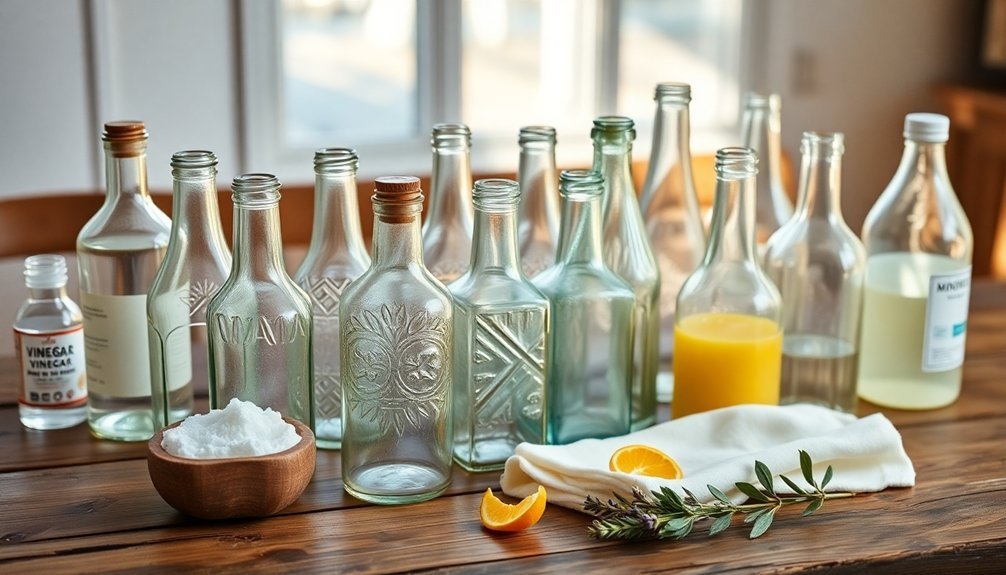
Before putting your collected bottles to use, proper cleaning and sanitizing will make certain your home fragrances remain pure and untainted. You'll need to start by removing labels and plastic coverings, then choose an effective cleaning solution from these proven methods:
| Cleaning Method | Purpose |
|---|---|
| Vinegar Solution | Dissolves oils without scratching |
| Rice Scrub | Gently removes stubborn residue |
| Alcohol Soak | Sanitizes and removes fragrance |
| Boiling Water | Deep sanitizes glass bottles |
After cleaning, sanitize your bottles using rubbing alcohol or an iodophor rinse. Don't forget to pay special attention to droppers by repeatedly filling them with cleaning solution. For stubborn labels, soaking the bottles in warm soapy water for 10-20 minutes will help loosen them. Always let your bottles dry completely before storing or reusing them. Remember to match the right caps and droppers to make certain proper sealing when you're ready to create your home fragrances.
Safety Guidelines for Repurposing Perfume Containers
Before starting your bottle repurposing project, you'll need to thoroughly clean and sanitize each container with warm, soapy water to remove any lingering fragrances.
You should carefully examine each bottle for cracks, chips, or structural weaknesses that could make it unsafe for reuse.
When handling perfume bottles, protect your hands from sharp edges around the neck or base, especially if you're removing old sprayer mechanisms.
Proper Cleaning Techniques First
Safe repurposing of perfume bottles starts with three essential cleaning steps to protect both you and your future fragrance creations.
First, you'll need to soak your bottles in warm, soapy water to remove labels and residue. Don't use harsh chemicals; stick to gentle dish soap or a vinegar solution. For stubborn labels, apply a mixture of baking soda and oil, letting it work its magic over time.
Next, clean the interior thoroughly with a small bottle brush, being careful not to scratch the glass. If you're dealing with essential oil residue, isopropyl alcohol can help dissolve stubborn films.
Finally, dry your bottles upside down and let them air out completely. You'll want to use a soft cloth for polishing to restore the bottle's shine before introducing your new fragrances.
Bottle Material Safety Check
When selecting perfume bottles for repurposing, you'll need to carefully evaluate their materials and structural integrity to ascertain they're suitable for your home fragrance projects.
Check for any cracks or damage that could compromise safety, and ascertain you're working with eco-friendly materials that your local recycling program accepts.
Before repurposing, remove non-recyclable components like sprayers and pumps.
If you're planning to modify the bottle, use appropriate glass adhesives and handle intricate designs with care.
You'll want to thoroughly clean the bottle to neutralize any residual fragrances and test material compatibility before applying new coatings or paints.
Keep your repurposed bottles away from direct sunlight to prevent degradation, and encourage others in your community to embrace sustainable practices through creative bottle reuse.
Handling Sharp Glass Parts
Proper handling of sharp glass edges marks the difference between a successful upcycling project and a trip to the emergency room. Before you start working with any bottle, inspect it thoroughly for jagged edges or cracks that could pose a risk.
Always wear protective gloves when handling glass and keep your workspace well-lit and clutter-free. When removing pumps or caps, do so carefully to avoid creating new sharp edges.
You'll want to smooth any rough spots using fine-grit sandpaper, followed by gentle polishing with steel wool. If you need to use pliers, wrap the glass with a protective cloth first to prevent additional damage.
Remember to keep sharp objects away from your work area and never leave partially processed bottles unattended, especially if there are children or pets nearby.
Creating Your Signature Home Fragrance Blend
You'll want to start your signature home fragrance blend by selecting complementary essential oils from your preferred fragrance family, such as floral or woody notes.
Begin your layering process with lighter top notes like citrus, followed by heart notes and base notes to create depth and longevity in your custom scent.
For the best results, test small batches of your blend before committing to larger quantities, allowing each combination to settle for 24-48 hours to understand how the fragrances interact.
Essential Oil Mixing Tips
Creating a signature home fragrance blend requires understanding essential oil characteristics and proper mixing techniques.
You'll want to start by selecting oils from compatible fragrance families and testing them on perfume strips to gauge their aromas and strengths.
When mixing, follow the 30-50-20 rule: 30% top notes, 50% middle notes, and 20% base notes for a well-balanced blend.
Begin with a base of 100 drops to make scaling easier, and use pipettes for precise measurements.
Always store your creations in amber glass bottles to protect them from light degradation.
Remember to let your blend rest for 48 hours to mature, and never exceed a 3% dilution rate for skin-safe applications.
Test your blend by wafting the scent strips rather than direct inhalation.
Scent Layering Basics
When developing your signature home fragrance, understanding scent layering basics can transform your space into a personalized aromatic haven. You'll want to start with lighter base notes and gradually build complexity by adding complementary scents. This technique enhances both the depth and longevity of your fragrances, as different notes evaporate at varying rates.
| Base Notes | Middle Notes | Top Notes |
|---|---|---|
| Fresh Linen | Lavender | Citrus |
| Vanilla | Rose | Mint |
| Sandalwood | Jasmine | Bergamot |
| Cedar | Ylang Ylang | Pine |
Remember to adjust your layering based on room size and seasonal preferences. You'll find that warmer scents work better in winter, while lighter fragrances shine in summer. Start with small amounts and let each layer settle before adding the next to create a perfectly balanced blend.
Tools and Materials Needed for Bottle Conversion
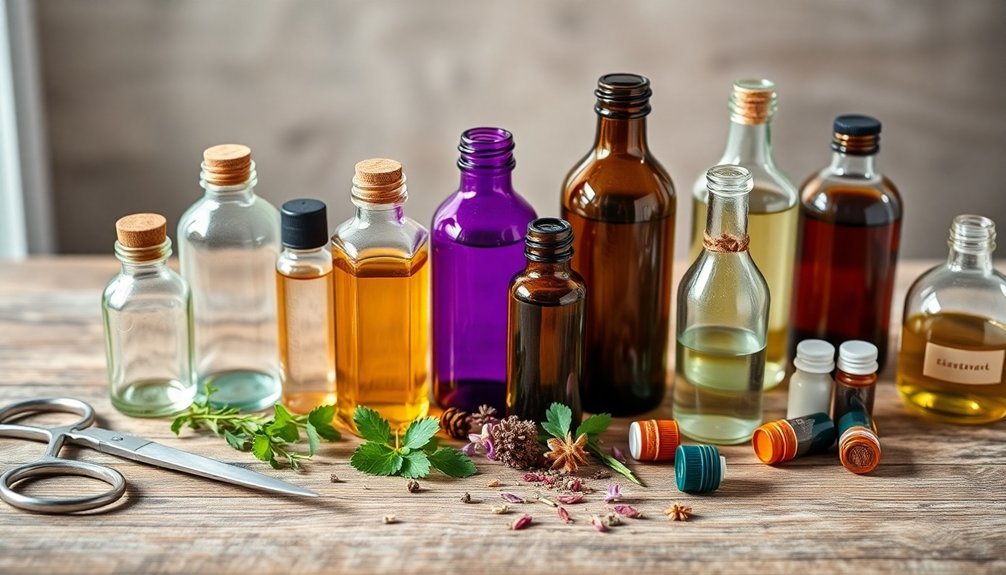
The successful conversion of bottles into home fragrance vessels depends on having the right tools and materials at your disposal.
You'll need a combination of essential tools and safety equipment to guarantee proper handling and transformation of your bottles.
- Start with perfume refill pump tools and syringes for precise liquid transfer.
- Gather glass bottles, cotton wicks, and diffuser nozzles for the conversion.
- Keep cleaning supplies ready, including mild soap, alcohol, and rags.
- Use protective gear like gloves and a padded work surface.
Remember to prioritize safety while handling glass and make sure you're working in a well-ventilated area.
Step-by-Step Guide to Bottle Preparation
Proper preparation serves as the foundation for successfully repurposing bottles into home fragrance vessels.
You'll need to start by completely emptying your bottle, using any remaining perfume as a room freshener. Next, soak the bottle in warm, soapy water, using a baking soda and cooking oil mixture for stubborn residues.
Once you've cleaned the interior, focus on removing labels and adhesive from the exterior. You can peel them off or use hot water to soften them.
After the bottle is completely clean, sanitize it with distilled water and let it dry thoroughly.
Don't forget to inspect for any cracks or damage – if you find any, it's best to recycle the bottle instead. Remember to handle the glass with care throughout the process.
Common Mistakes to Avoid When Repurposing Bottles
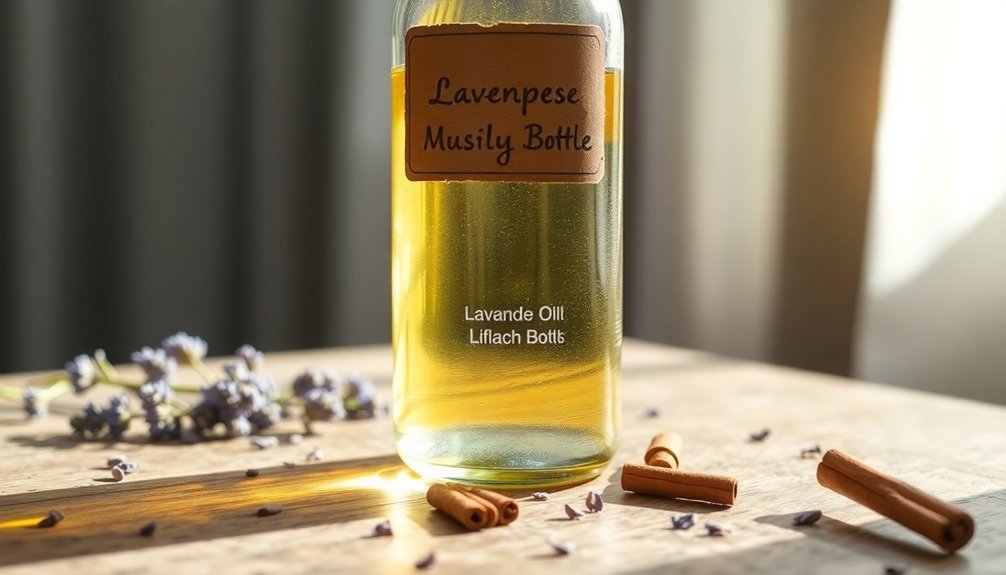
Successfully repurposing bottles requires avoiding several common pitfalls that could compromise your project's outcome.
Don't rush the preparation process, as proper cleaning and handling are essential for success.
Here are the key mistakes you'll want to avoid:
- Putting bottles in the dishwasher – this can cause cracking and breakage due to high pressure and temperature.
- Using harsh chemicals or excessive scrubbing – these can damage the glass surface and leave permanent marks.
- Skipping the soaking process – tough residues won't come off without adequate soaking time.
- Ignoring faulty seals or corks – improper sealing can lead to leakage and compromised fragrance storage.
Remember to handle your bottles with care and keep them away from direct sunlight to maintain their aesthetic appeal and functionality.
Cost-Saving Benefits of Reusing Fragrance Containers
You'll notice significant savings on your monthly fragrance expenses when you start reusing containers instead of buying new ones for each refill.
Creating your own DIY home fragrances in repurposed bottles can cut costs by up to 70% compared to purchasing pre-made alternatives.
These savings quickly add up over time, especially when you consider that quality fragrance containers can cost as much as the scents themselves.
Reduce Monthly Fragrance Expenses
Three significant cost-saving benefits emerge when you repurpose fragrance containers for home use.
By adopting this eco-friendly practice, you'll notice an immediate reduction in your monthly fragrance expenses while maintaining the same quality of scents you love.
- Switch to refills instead of buying new bottles, saving up to 40% on your fragrance purchases.
- Invest the money you save into trying new scents or premium fragrances you've always wanted.
- Reduce packaging costs by eliminating the need for new containers with each purchase.
- Maximize your budget flexibility by spreading out your fragrance expenses more effectively.
You'll find that repurposing containers isn't just environmentally responsible – it's a smart financial strategy that lets you enjoy your favorite scents while keeping more money in your pocket.
DIY Savings Add Up
Making your own fragrances with repurposed bottles leads to substantial cost savings beyond the initial container reuse.
You'll save money by eliminating the need to purchase new containers while creating custom scents that suit your preferences. By using natural ingredients like essential oils and herbs, you're also reducing your reliance on expensive commercial products.
These DIY solutions offer multiple cost-cutting opportunities. You can transform your old perfume bottles into room sprays, diffusers, or plant misters, maximizing their utility.
The versatility extends to creating unique gift options – fill these repurposed containers with your homemade fragrances for thoughtful, budget-friendly presents.
You're not just saving money; you're also supporting sustainable practices by reducing waste and minimizing the demand for new materials.
Creative Ways to Decorate Your Repurposed Bottles
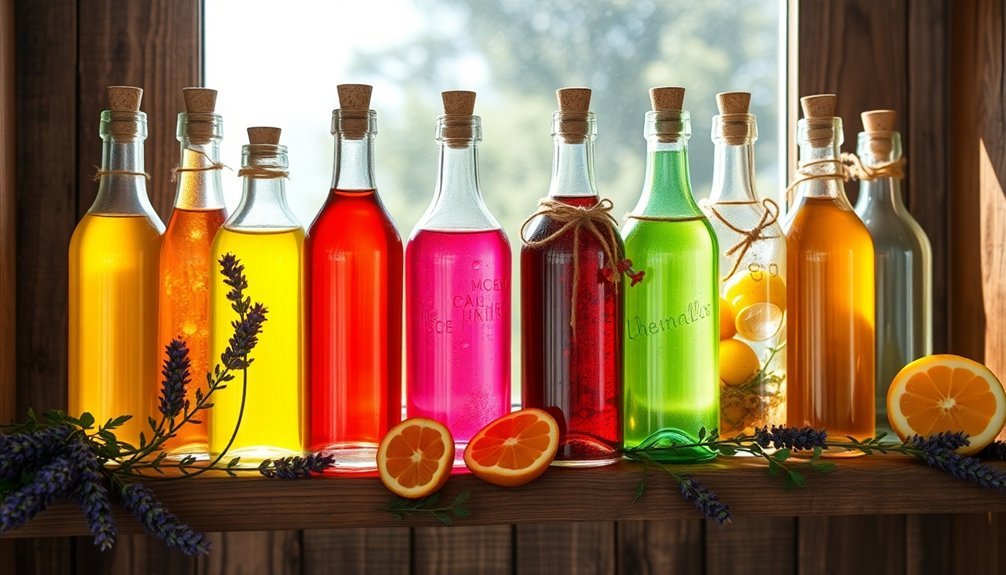
While transforming old bottles into home fragrance containers is rewarding on its own, decorating them adds a personal touch that can complement any home décor style.
You'll find endless possibilities to express your creativity while being environmentally conscious.
- Wrap your bottles with natural twine or rope to create rustic patterns, perfect for farmhouse-style décor.
- Apply decoupage using recycled paper or fabric scraps to design unique patterns that match your interior.
- Create coastal-themed containers by adorning them with seashells, sand, and beach-inspired elements.
- Embellish with beads, artificial flowers, or glitter for an elegant look that sparkles.
Don't forget to seal your artwork with varnish for protection and longevity.
These decorated bottles can become stunning centerpieces that showcase both your creativity and commitment to sustainability.
Storage and Maintenance Tips for DIY Fragrance Bottles
To maximize the longevity and potency of your DIY home fragrances, proper storage and maintenance of your repurposed bottles is essential.
Store your bottles in a cool, dark place with temperatures between 50°F and 70°F, and keep humidity levels low to prevent degradation.
Maintain fragrance quality by storing bottles at 50-70°F in a cool, dark environment with minimal humidity.
Before using any repurposed bottle, verify it's thoroughly cleaned and free from residues.
Don't use bottles that previously contained oil-based products, as they can contaminate your fragrances.
You'll want to store your bottles in their original packaging or UV-resistant containers to protect them from light damage.
Remember to check your bottles regularly for signs of discoloration or deterioration.
Rotate your fragrances to use older ones first, and avoid excessive handling or shaking, which can introduce unwanted air and lead to oxidation.
Frequently Asked Questions
How Long Does Fragrance Last in Repurposed Bottles Compared to Original Packaging?
Your fragrances will typically last 10-20% less time in repurposed bottles compared to original packaging, but you can extend their life by ensuring proper cleaning, sealing, and storage in cool, dark places.
Can Vintage Perfume Bottles Contain Harmful Materials Like Lead Crystal?
Yes, your vintage perfume bottles can contain harmful lead crystal, which may leach toxic substances. If you're concerned, you can have them tested or opt for modern glass bottles instead.
Which Essential Oils May React Negatively With Recycled Perfume Bottle Materials?
You'll need to watch out for citrus, peppermint, tea tree, and eucalyptus oils, as they can react with plastic components. Even lavender oil may degrade if exposed to UV light through clear containers.
Are Certain Fragrances More Likely to Stain or Damage Repurposed Bottles?
Yes, darker and highly concentrated fragrances with intense pigments are more likely to stain your bottles. Oil-based scents and those containing acidic ingredients can also damage glass surfaces over time.
What's the Best Way to Remove Stubborn Bottle Labels Without Damaging Glass?
Soak your bottle in hot water and dish soap for 30 minutes. Then, apply rubbing alcohol to dissolve stubborn adhesive. You can gently scrape remaining residue with a plastic scraper or use baking soda paste.

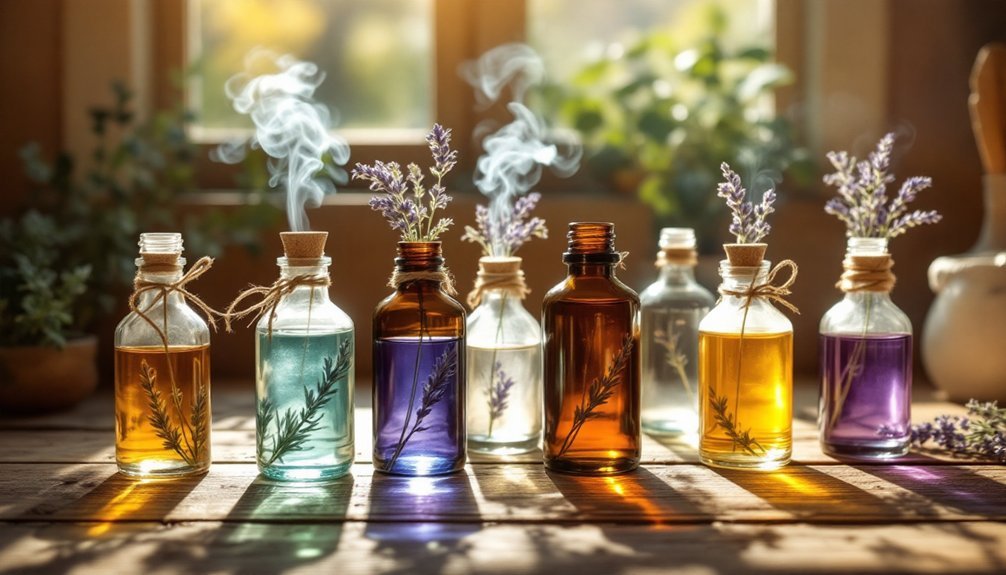
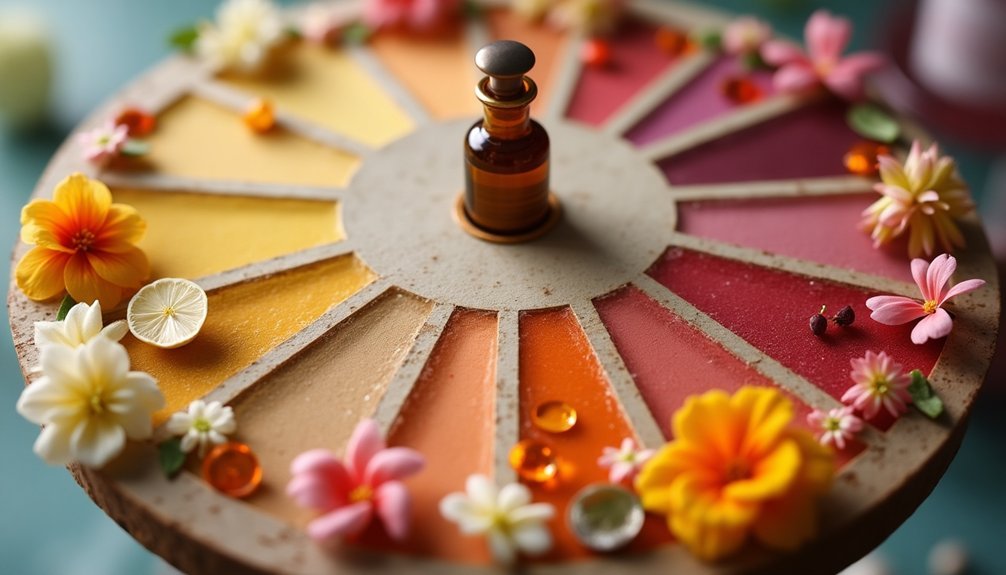
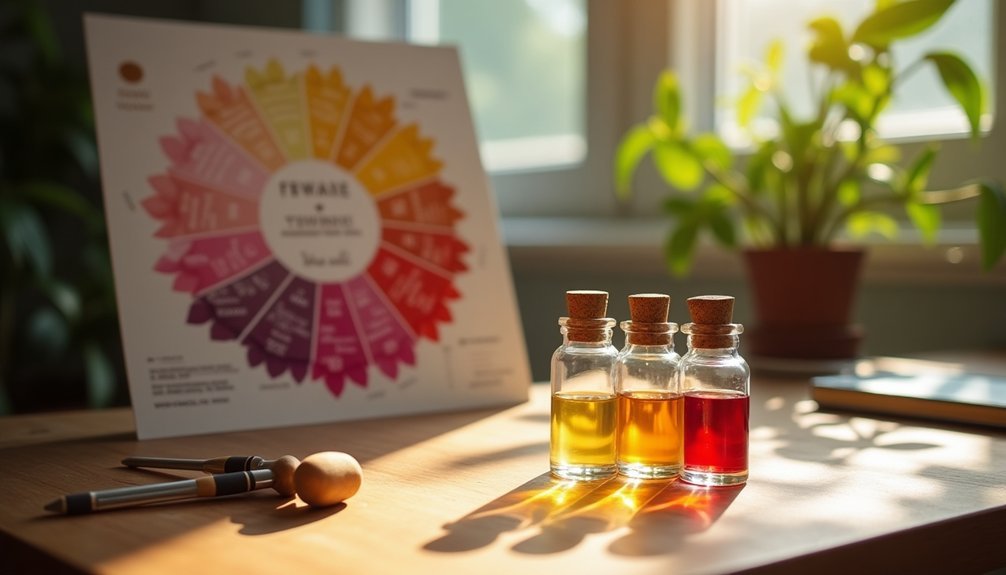

Leave a Reply